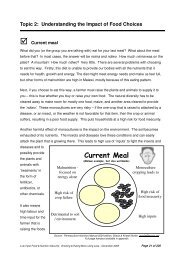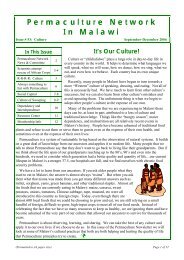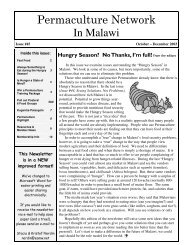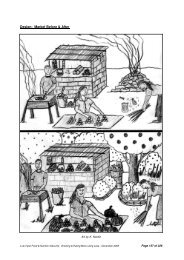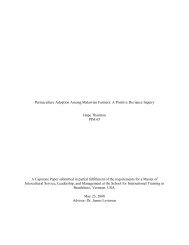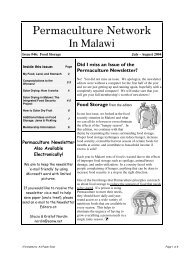Harmonisation of seed laws in Africa.indd - Never Ending Food
Harmonisation of seed laws in Africa.indd - Never Ending Food
Harmonisation of seed laws in Africa.indd - Never Ending Food
You also want an ePaper? Increase the reach of your titles
YUMPU automatically turns print PDFs into web optimized ePapers that Google loves.
GRICULTURE, ENERGY AND LIVELIHOOD SERIES<br />
ma<strong>in</strong>ly by resource-poor farmers, it is not surpris<strong>in</strong>g that OPVs still dom<strong>in</strong>ate. This goes for maize as<br />
well as other crops, although hybrid maize <strong>seed</strong> is expand<strong>in</strong>g on the cont<strong>in</strong>ent.<br />
Maize as the ‘th<strong>in</strong> edge <strong>of</strong> the wedge’<br />
The ma<strong>in</strong> exception to farmer-controlled <strong>seed</strong> systems <strong>in</strong> <strong>Africa</strong> is maize hybrids, which have been<br />
‘the ma<strong>in</strong> growth eng<strong>in</strong>e for formal sector <strong>seed</strong> and for pr<strong>of</strong>itable commercial enterprise <strong>in</strong> <strong>Africa</strong>’. 17<br />
Maize is a staple food <strong>in</strong> large sections <strong>of</strong> <strong>Africa</strong>. In 2007 maize accounted for 56 per cent <strong>of</strong> the total<br />
harvested area <strong>of</strong> annual food crops <strong>in</strong> sub-Saharan <strong>Africa</strong> (SSA), 43 per cent <strong>of</strong> which is <strong>in</strong> southern<br />
<strong>Africa</strong>. 18<br />
Because maize is so widely grown <strong>in</strong> the region, and because <strong>Africa</strong>n yields are so low when<br />
compared with other parts <strong>of</strong> the world, much attention has been paid to the improvement <strong>of</strong><br />
maize varieties <strong>in</strong> <strong>Africa</strong>. Adoption rates <strong>of</strong> improved maize varieties (80 per cent hybrid and 20 per<br />
cent open-poll<strong>in</strong>ated) are highest <strong>in</strong> South <strong>Africa</strong>, Zimbabwe (80 per cent), Zambia (73 per cent)<br />
and Kenya (72 per cent) and low <strong>in</strong> Angola (5 per cent), Mozambique (11 per cent), Tanzania (18 per<br />
cent) and Ethiopia (19 per cent). 19 Rapid growth is be<strong>in</strong>g experienced <strong>in</strong> Zambia and Uganda and<br />
to a lesser extent Tanzania, Ethiopia and Malawi. Maize is thus an entry po<strong>in</strong>t for the expansion <strong>of</strong><br />
commercial <strong>seed</strong> systems <strong>in</strong> <strong>Africa</strong>.<br />
AGRA’s (Alliance for a Green Revolution <strong>in</strong> <strong>Africa</strong>) activities re<strong>in</strong>force this perception. Almost twothirds<br />
<strong>of</strong> AGRA’s Seed Production for <strong>Africa</strong> (SEPA) programme grants by value from 2007 to 2012<br />
were allocated to maize, followed far beh<strong>in</strong>d by cassava and groundnuts as other crops with<br />
commercial potential. 20<br />
Markets and systems <strong>of</strong> production and distribution can be built and extended through<br />
commercialisation <strong>of</strong> the maize sector. In this way it can be understood as ‘the th<strong>in</strong> edge <strong>of</strong> the<br />
wedge’, <strong>in</strong>troduc<strong>in</strong>g new systems that l<strong>in</strong>k to the expansion <strong>of</strong> a class <strong>of</strong> commercial farmers.<br />
Markets for both <strong>seed</strong> and imported synthetic agrichemicals are created. Where the colonialism<br />
<strong>of</strong> the past was largely about the extraction <strong>of</strong> natural resources as cheaply as possible, the new<br />
wave <strong>of</strong> capitalist <strong>in</strong>vestment <strong>in</strong> <strong>Africa</strong>n agriculture is about build<strong>in</strong>g domestic markets while also<br />
extract<strong>in</strong>g surpluses <strong>in</strong> the form <strong>of</strong> debt repayments and dividends.<br />
However, the basic <strong>in</strong>frastructure is not <strong>in</strong> place, and states do not appear able to create it. AGRA<br />
and others are do<strong>in</strong>g the groundwork <strong>of</strong> build<strong>in</strong>g domestic scientific capacity (with mult<strong>in</strong>ational<br />
technical and f<strong>in</strong>ancial backup), and build<strong>in</strong>g basic production and distribution capacity and<br />
systems <strong>in</strong> and outside the state.<br />
Intellectual property rights and<br />
ownership <strong>of</strong> germplasm<br />
IP is a form <strong>of</strong> bus<strong>in</strong>ess regulation, not a fundamental aspect <strong>of</strong> human needs. As such it<br />
is a subord<strong>in</strong>ate activity that should be modified, reviewed and restructured accord<strong>in</strong>g to<br />
how it helps or h<strong>in</strong>ders the meet<strong>in</strong>g <strong>of</strong> human needs. …the measures by which it is judged<br />
requires a far wider range <strong>of</strong> <strong>in</strong>puts than those from legal and technical groups that make<br />
up the IP community and which dom<strong>in</strong>ate the practise <strong>of</strong> WIPO. Sisule Musungu 21<br />
<strong>Harmonisation</strong> <strong>of</strong> <strong>Africa</strong>’s <strong>seed</strong>s <strong>laws</strong>: a recipe for disaster 11



